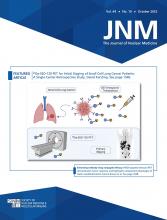TO THE EDITOR: We read with interest the article “PSMA-GCK01: A Generator-Based 99mTc/188Re Theranostic Ligand for the Prostate-Specific Membrane Antigen” in The Journal of Nuclear Medicine (1). It is noteworthy that kidney accumulation of 188Re-PSMA-GCK01 in LNCaP tumor–bearing mice was found to be 14 times higher than tumor uptake 1 h after injection and 9 times higher 2 h after injection (1).
It is worthwhile to investigate 188Re as an alternative to 177Lu, because accredited 177Lu radiopharmaceuticals are available and the amount of 177Lu is limited. Further alternatives such as 161Tb (2) or 67Cu (3) are moving into the focus of clinical research and could have even better therapeutic properties because of the coemission of Auger–Meitner electrons.
However, the kidney geometry in small animals is not representative for humans regarding geometry and pathlengths of the β-emission. Recently, Vargas et al. presented a method to understand the heterogeneity of absorbed doses in the kidneys of mice (4). In humans, the heterogeneity of absorbed doses in, for example, kidneys is crucial for the application of therapeutic radiopharmaceuticals (5). Hence, studies in pigs (single kidney weight, 125 g for pig vs. 150 g for human) may be required. Further, most patients currently receive radionuclide therapy as the last line of treatment after previous hormone and chemotherapy, so that bone marrow and kidney function may already be predamaged. This effect, too, can neither be simulated nor reproduced in animal experiments but requires clinical testing.
In our own efforts on 188Re-PSMA derivatives, we found that biokinetics must be considered in terms of the physical half-life of the applied isotopes: at 17 h (188Re) versus 6.6 d (177Lu), the initial phase is more significant for 188Re, and this is the phase with the greatest renal accumulation or excretion. Dosimetric calculations for 177Lu-PSMA by Kurth et al. revealed kidney doses between 2.9 and 3.7 Gy, depending on the therapeutic cycle (6). On the basis of the effective half-lives for the kidneys that were reported, we calculated the biologic half-life for PSMA in the kidneys. We identified the expected effective half-life for 188Re-PSMA by assuming a biodistribution identical to that for 177Lu-PSMA and using the physical half-life for 188Re. The calculated number of 188Re decay in the kidneys was found to be approximately 66% lower than that of 177Lu-PSMA decay. Nevertheless, the S value, S(kidney←kidney), for 188Re is 5 times higher than that for 177Lu. This means that the dose to the kidney is expected to be 1.7 times higher when using the same activity for 188Re-PSMA as for 177Lu-PSMA. The dose would be even higher when the initial kidney biokinetic is considered more accurately by assuming a linear accumulation within the first 2 h (6).
Furthermore, radiation biology must be considered, as higher activity levels must be used to achieve the same dose because of the shorter half-life of 188Re. The authors used the same activity of 188Re-PSMA and 177Lu-PSMA (3.7 GBq) (1). Assuming an identical tumor uptake in a lesion with a mass of 10 g, the absorbed dose of 188Re will be only 51% of the absorbed dose of 177Lu. Hence, in therapeutic applications, the activity of 188Re must be twice the activity of 177Lu to achieve the same tumor dose. Furthermore, the various effective half-lives must be considered with respect to cellular repair mechanisms. The biologically effective dose is expected to be about 25% higher from 188Re than from 177Lu for equal absorbed doses. In conclusion, it is necessary to consider the dosimetric consequences carefully when replacing 177Lu with 188Re as mentioned above.
Marc Pretze*, Jörg Kotzerke, Robert Freudenberg, Claudia Brogsitter
Technical University Dresden, Dresden, Germany
*E-mail: marc.pretze{at}ukdd.de
Footnotes
Published online Aug. 3, 2023.
- © 2023 by the Society of Nuclear Medicine and Molecular Imaging.
REFERENCES
- Received for publication May 17, 2023.
- Revision received June 14, 2023.







